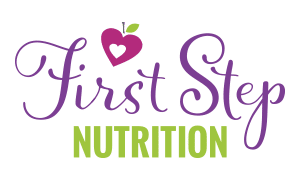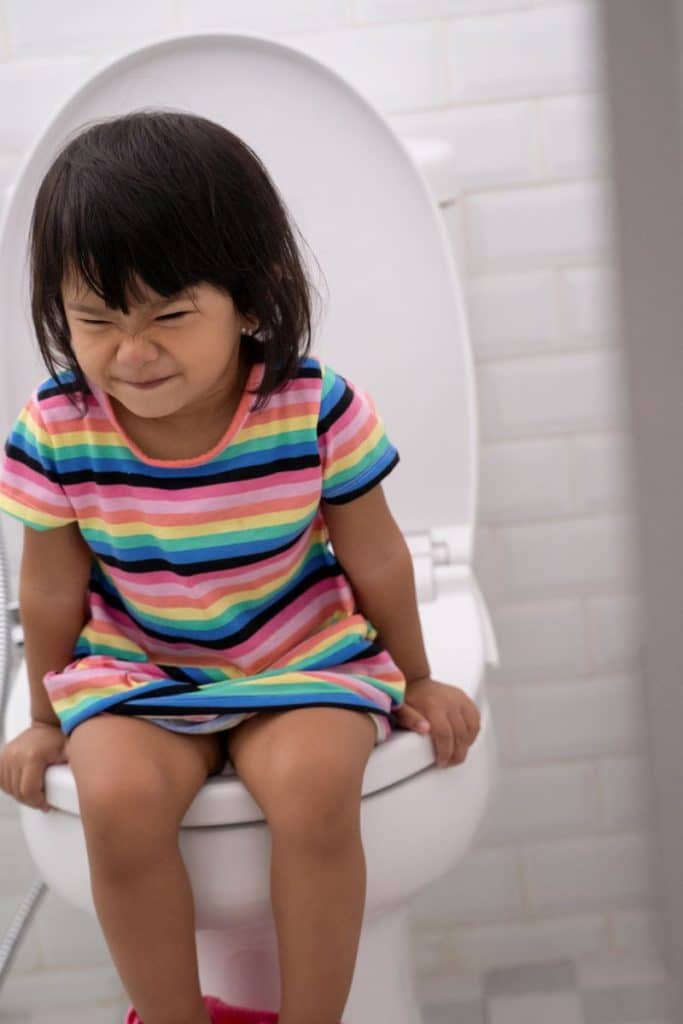
9 Natural Laxatives for Kids & My Personal Story with Restoralax
What is constipation, and how do you treat it in children? This blog discusses nine natural laxatives for kids to cure constipation and laxative options that work. This post contains affiliate links which won’t change your price but will share some commission.
Difficulty pooping is a regular challenge for about half of my family members (I guess it’s genetic…). When my youngest son was three months old, I called 311 (a nurse helpline) as he was rarely pooping. And only painful, hard, dry nuggets, poor lil’ guy. And he was exclusively breastfed!
We recently visited the pediatric GI doctor for the same issue, which led to anal fissures. Personally, I’ve tried physio, acupuncture, naturopath, and diet, of course (being a dietitian myself!) with mixed success.
It’s difficult to watch your little one in pain while trying to pass stool because they are so backed up! And it can be a destructive cycle because if it hurts to poo, they may start holding it in, which makes the situation even worse. In this blog, I’ll discuss constipation and the many treatment and prevention options.
What is constipation in children?
The first thing to consider if you think your young child is constipated is the definition. The Canadian Pediatric Association defines constipation as “ bowel movements that occur less often than usual, hard and dry, and/or painful or difficult to pass.”
So it’s not just having regular bowel movements but the consistency that counts too. Your exclusively breastfed infant isn’t constipated when they don’t poo for a week, as long as their poo is regular breastfed-baby-poo consistency!
About 1 in 10 children have constipation. And for 1/3 of them, it will continue into adulthood as chronic constipation.
Causes of pediatric constipation
Constipation in infants and children can be due to toilet training or starting daycare. The child may withhold going to the bathroom, which dries stools out and leads to constipated children.
Starting solid foods is another typical time to see constipation. It can take a while for the gut to figure out how to process these solids, not just breast milk!
If constipation is a constant problem, take your baby to the doctor to ensure there is no medical condition or underlying causes. Especially if your babe also has more symptoms of severe constipation like fever, abdominal distention has stopped eating, has blood mixed with stool, has slow weight gain or has weight loss.
Most healthy children with constipation have no underlying cause, and it’s called functional constipation.
As for diet, here are some natural foods and supplements that can help prevent functional constipation. These are alternatives to Miralax for toddlers to manage constipation for some children. I’ll also talk about laxatives for those for which it doesn’t help.
Natural Laxatives for Kids
1) High Fibre Foods:
Insoluble fibres like bran bulk up the stool. The old dietary fibre recommendation I often still use is your child’s age +5 grams of fibre per day at minimum.
The newer Dietary Reference Intakes include all fibre in the child’s diet (including extra fibres added to many foods now, like inulin). These recommended intakes are 19g of fibre intake per day for a 1 to 3-year-old and 25g per day for a 4 to 8-year-old.
As many adults struggle to get this amount of high-fibre foods, I feel this fibre intake is too lofty a goal for young children. Besides, their tummies are small, and 19g of fibre wouldn’t leave them hungry for more calorie-dense foods.
If you offer one fibre-rich food at each meal, your child should get adequate fibre. Here are some examples of high-fibre foods:
- Fruits and vegetables (especially with the skins on)
- Whole grains instead of refined (try this Apricot Oatmeal Bran Muffin)
- Beans and legumes
- Oats. Beta-glucan fibre in oats is an especially beneficial fibre to help with constipation.
- Ground Flax: Flax has been shown to treat constipation better than psyllium fibre (found in Metamucil). Add 1 Tbsp daily to a smoothie, oatmeal, yogurt or applesauce.
Note: If you’re increasing fibre, make sure FLUID is increased along with fibre to push things along!
2) Water:
Water is the only thing that helped my babies with their constipation. Not fibre, juice, prunes – just simple water.
My youngest boy refused to drink from an open cup or bottle when he was a baby, but I found he would take water from a dropper just fine.
If your baby or child doesn’t drink much (or any water), give it a try to increase even by an ounce for young ones. For older kids, the American Academy of Pediatrics recommends 4 cups of fluid per day for a 1 to 3-year-old and 5 cups for a 4 to 8-year-old.
3) Laxative fruits and fruit juice:
Apple juice, pear juice, or prune juices help draw water into the bowels, act as a stool softener, and prevent painful bowel movements. It’s the sugar they contain called sorbitol that accomplishes this. Offer ¼-1/2 cups of juice per day for little ones with a meal.
And we all know that plain old prunes are a great natural laxative! Here’s a Prune Energy Ball recipe your toddler or preschooler might like. And I’ve also included a link to grab my Fruit Lax recipe at the end of this blog.
4) Probiotics:
While expensive, there is no physical harm to adding probiotics temporarily working toward creating a healthy gut. I like to use the website probioticchart.ca to determine which probiotics to use for different age groups and health concerns.
A study using lactobacillus casei in kids under age ten found improved stool frequency. But the research is conflicting. Another study found this probiotic didn’t help kids with constipation.
Culturelle has a powder and chews for kids. If you want to try it out, here’s an Amazon affiliate link:
Culturelle Kids Daily ProbioticL. reuteri is another strain of probiotics that has been shown to help with constipation in kids.
5) Senna:
While it’s considered a stimulant laxative, Senna is technically natural. It’s made from the leaves and fruit of the senna plant. You might hear it called Senekot – it’s found in ExLax.
Senna shouldn’t be used regularly, and it may cause side effects like cramping. I’ve used ExLax once, and it woke me up in the middle of the night with cramps, so never again!
But there are some more gentle senna formulas. You could try a senna supplement formulated for kids like this.
6) Consider Dairy Intolerance:
If your child is unresponsive to laxatives, their constipation may result from dairy intolerance.
When my 4-month-old was exclusively breastfed and still constipated, I took dairy out of my diet for a month (and I can tell you – there’s no decent substitute for cheese!). It made no difference, which is what most will find. But it’s worth a try if you can provide the nutrients in dairy from other food sources in your (or your child’s) diet.
7) Positioning and Routine:
If kids are sitting on a large toilet with their feet dangling, this does not support their bodies to have a comfortable bowel movement. A squatting position with knees above our hips will make it easier for the poop to come out.
So check out Amazon or stack up those step stools or boxes/books for your child’s toilet. Here’s an amazon affiliate link:
adjustable toilet step stool for kidsHaving a routine where your child sits on the toilet for a few minutes at a time they often poop (like right after breakfast) can also be beneficial. The body will get used to this routine and know it’s “poop time!”
8) Metamucil for Kids
Metamucil is just a source of fibre. It contains psyllium fibre from the psyllium plant. It adds bulk to the stool, making it softer (or “slick and gelatinous” as this study describes). Make sure to take Metamucil with lots of water, or it could worsen constipation.
The Apple Wafer (cookies) contains 4g fibre and 7g sugar. A 1 Tbsp dose of the classic orange-flavoured powder you can blend with water contains 3g of fibre and 8g of sugar. Here’s an Amazon affiliate link to the wafers:
Metamucil apple wafer cookiesI don’t love Metamucil’s added sugar or artificial sweeteners. They offer a non-sweetened powder version, but it tastes gross; you could mix it into smoothies.
9) Magnesium for kids:
Magnesium oxide is often used for the treatment of constipation. Since it’s the form of magnesium that is absorbed the poorest, much of it ends up in the poop, drawing water with it to soften hard stool.
There have been concerns about whether taking magnesium supplements may cause increased blood levels of magnesium. This is unlikely with Magnesium Oxide, as only 4% is absorbed. Hypermagnesemia is shown to be a concern rarely and mostly in people who don’t have properly working kidneys.
How much magnesium should a child take for constipation? This study used a magnesium dose of 30mg/kg body weight. For example, a 40-pound child (18kg) would take about 540mg. In this study, magnesium did work to treat constipation. But of interest is that it also altered the gut microbiota. This could be concerning and something that needs more research.
I asked the gastroenterologist about magnesium vs. Restoralax. I’ve actually asked two pediatric gastroenterologists about this. They both had the same answer. They prefer Restoralax, as it’s not absorbed at all (more on that below).
What about Laxative treatment for constipation in kids?
One of my children had blood in the stool recently. He had an abdominal x-ray, which the GP said looked fine. But the pediatric gastroenterologist looked at his x-ray, conducted a physical examination, and said he was full of poo.
Then once finding out I was a dietitian, the GI doc first laughed at me; I guess I’m my own best case study! And then, he recommended Polyethylene Glycol (PEG – brand names Restoralax, Lax-A-Day or MiraLax) daily to produce a soft bowel movement. Or “soft snake poos,” as he called them! When you look at the Bristol Stool chart, the ideal poop would be #4.
Here’s an Amazon affiliate link if you want to try it out:
RestoralaxPolyethylene Glycol (Restoralax) for Toddlers
For some people, diet, physical activity and fluid are insufficient to treat constipation. And the problem with constipation is that it can quickly become a chronic problem. Your intestines get “lazy.” And also, fear of pooing for a child because it hurts causes them to hold it, which dries the stool out more. It can become a vicious cycle.
I was surprised by the Restoralax dose for a child. He recommended an amount similar to adults. I’m not saying this is the same recommendation your doctor would give you, so ask your doctor.
And the Restoralax worked…until I got lazy, and we ran into the same problem. This time it came along with stomach pain and nausea for the poor little guy….while we were on vacation, of course!
So, back to the Restoralax! We’ve fallen into about an every 2-3 day dose, which seems to be working. You can also decrease the dosage and offer it daily to find an amount that leads to soft stools but not diarrhea.
Is Restoralax safe?
I’ve heard lots of rumours online that PEG is toxic. But basically, everything is toxic, according to random people on Google…
If I give this to my child regularly, I want to ensure it’s safe and doesn’t adversely affect children. Even the Restoralax website says it’s not for children, even though doctors always recommend it.
There has been a fair amount of research on PEG in children. One study with 83 children taking restoralax for an average of 8.7 months found normal serum electrolyte levels, osmolality, albumin levels, and liver and renal function test results.
And a review study comparing laxatives in child constipation found polyethylene glycol was safe and had lower rates of minor side effects compared to other laxatives. It also works better than other osmotic laxatives that draw water into the bowels to soften stool, like lactulose.
Restoralax side effects
Common side effects of laxatives include gas, abdominal pain, nausea, diarrhea and headaches. Restoralax claims not to cause any of these, but I’ve heard otherwise from some moms. Personally, it gives me gas. As with everything, it would be individual.
Other Laxative Options
Suppositories are also an option if you need a quick fix, but they can be painful. Talk to your healthcare provider first. Milk of magnesia, lactulose or corn syrup can also work as stool softeners in infants and children. If the natural options aren’t working, ask your doctor and pharmacist what’s best for your child.
In Summary
Constipation is a prevalent and challenging issue in children (and adults!). I hope the natural options work for you. If not, you’re not a failure if you have to use laxatives – Restoralax is safe. We continue to use it regularly in our house. Best of luck!
Want to grab my free Fruit Lax recipe to help clear up constipation? Click here to get the recipe.
Founder of First Step Nutrition | Registered Dietitian Nutritionist
Jen believes raising happy, well-nourished eaters who have a healthy relationship with food doesn't have to be a battle! She is an author and speaker with 18 years of experience specializing in family nutrition and helps parents teach their kids to try new foods without yelling, tricking, or bribing.







No Comments